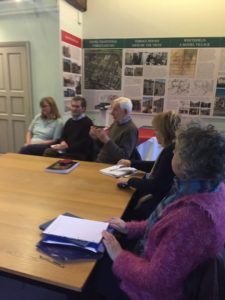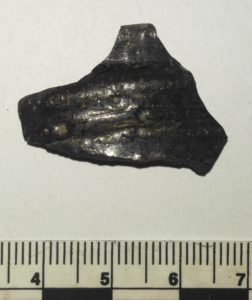Dr David Taylor gave an interesting talk to a good group of members, he started by saying that during the time leading up to WW11 pottery did not play a major part in archaeology nor was it well researched. Over the years this view of the importance of pottery has changed and there has been much research in the area. Apparently pottery is classified into pottery series for example Dragonsdorf named after the chap who originally researched and classified it.

Members listening to the talk on PAS. Jan 2020. Attribution:GW
The three properties of pot are that it is indestructable (well relatively!) and very importantly it is dateable and it is also a reflection of the culture of a people and their times. The nearest site for the basis of pot making is clay, locally our sources came from Cliviger, an underlying factor is that clay has to be easily obtainable. The properties of clay are adjusted by adding fillers, sand or silica or other material for example shells. Human and animal bone has also been included in the mix at times. Clay was moulded by hand or thrown on a wheel then dried and fired. A very basic way was to put the pot in an open fire methods then progressed to firing the pot in kilns.
Biscuit ware is apparently the simplest form of pot. Slipware is a liquid clay which is added to waterproof the pot, reducing its porosity, this can be done inside and outside the pot. The earliest pots were hand coiled or moulded and produced by the Beaker people – Belgic tribes, mainly consisting of food vessels and collared urns, produced in the Mid to Late Bronze Age (BA) which eventually reached our eastern British shores. Vases with a hare or deer were common in Iron Age times and reflect the culture of the time.
The Romans relied heavily on pot for food vessels, both cooking and storage, amphora mainly for wine, flagons and other household items such as lamps. This was divided into coarse or fine ware, the Romans used a lot of slip ware and also Samian ware or Terra Sigillata mostly created in south, east and central Gaul and Spain although at one point Colchester produced some inferior Samian ware. Apparently Samian ware was produced by the Romans before the occupation of Brittanica and up to 250 AD when the Brits started making their own. Finding Samian ware is very useful to the archaeologist as it can be very tightly dated, due to the date stamp. Samian ware was produced in molds in standardised forms. A military works depot or tile works has been found at Holt near Chester, of course tiles were used for flooring as well as roofing. Floor tiles could be as much as 1 or 2ft. square and 3inches thick.

Opus Signinum: Attribution: Peter Hess
It was very interesting to find out the nature of Opus signinum, a type of building material used in ancient Rome usually for flooring. It is made of broken tiles, river gravel or very small pieces of stone mixed with lime or clay mortar, and then beaten down with a rammer. If you have been in any British public building you will be very familiar with Opus signinum. A technique the Romans inherited from the Phoenicians.
David also discussed Grey ware, Black Burnished ware, Fine ware, Rusticated ware. Tokesey ware produced in Anglo Saxon times was found around the East coast sadly the North West appears to have been aceramic in those times. Moving on to Mediaeval times and the 12th and 13th centuries where the monks brought with them from France their knowledge of building and making pottery which included floor tiles. It is thought that North Yorks. glazeware was produced at Riveaulx Abbey.

Find Of The Day – rim sherd of a late Medieval/early Post Medieval vessel. Attribution: Alex Whitlock
At the end of the presentation David outlined the pottery that was found at Park Hill in the ground floor of the Museum where a dig took place around thirty years ago. Most of the shards appeared to be from pots brought over from east Yorkshire, Humber ware. However there was a pot with a pie crust rim internally glazed and with a bung…. these finds should be able to be viewed in the Museum.
It’s quite exciting to wonder who made a pot, where it was made and ascertain its usage and of course one has to wonder how it came to be in the place it was found for example a tiny piece of Samian Ware 1,000 feet up a hill in the Yorkshire Dales. There is nothing better when one has scrabbled about in the soil in the cold and damp and worse for hours to turn up a sliver of pottery that can be dated and help to put a particular site on a map.
Did you know?
That amphorae were transported by putting the bottom layer in clay and then fitting the other layers inbetween the spaces?
That Terra Sigillata means earth with dancing figures?
That Potsilana was Rome’s secret weapon in construction, it’s a type of waterproof concrete that has endured for millenia and enabled the most remarkable feats of engineering?
That carrying points on pottery were deliberately roughened to ensure that they did not slip out of greasy hands?
Banner Image: Three ceramic roof tiles which are curved and are handmade. They are probably Roman imbrices. The fabric is orange throughout. It is soft and rough and the texture is hackly. The inclusions are frequent and are poorly sorted. They are mainly sand and quartz. The breaks are abraded. Attribution: Portable Antiquities Scheme, British Museum